Challenges of Contemporary Sensemakers
The following is the transcript of an annual address I gave at Makesensemess on November 1st 2024.

To kick off my annual address, I want to acknowledge the elephant in the middle of this global, virtual room. The world is a hot mess, literally.
Here in the US we are days away from the results of our latest election of a lifetime. Genocide, isms, and phobias of all kinds seem to be on the rise, and along with them oceanic temperatures, extreme weather events, joblessness, houselessness, and burnout are all also on the rise.
… how could burnout not be on the rise at the tail end of that list?!
If we zoom in a level to reflect not on the world as a whole, but on our own niche sensemaking community, that same hot mess is staring us down and demanding our lunch.
Our job roles are a scattered mess, and with it a tangle of job titles stuck at various stages of transition between digital epochs. Reorgs, layoffs and mergers are quarterly if not monthly occurrences in many organizations. New tools become the du jour which spurs old tools to scramble to become or buy the du jour. Design theater is part of the return to office movement, and senior folks calling out these realities are being replaced by newer, less expensive models.
All the while, the cycle is cycling and the things we are making sense of stick around for less and less time than ever before. Objective truth is less and less clear cut, and reality feels more subjective every day.
In other words, contemporary sensemaking challenges have never been more complex, ephemeral or obtuse. And with that statement is a great realization of the anxiety that must be present in every sensemaker listening to this talk today.
Simply put, if you are practicing as a sensemaker today, or plan to in the coming years know that this is uncharted sensemaking territory that we are facing ahead.
At this point in writing this talk I wrote in the margins
“Damn Covert, this talk is grim.”
But I also decided in that moment to proceed as planned, because I refuse to report sunny weather when we are batting down our sensemaking hatches to prepare for another metaphorical, if not literal hurricane.
The theme of this year’s event is change takes time. And we have a ton of change ahead, and we don’t know how much time we get. This is the kind of desperate ambiguity that calls for only one salve. Community.
When I started The Sensemakers Club it was from a place of desperate realization about how far our sensemaking community was spreading thin what had been ample in supply to me when I first started as an IA. Basics like knowledge sharing, mentorship, peership and networking were natural resources in this industry that many of us had taken for granted until they started to dry up.
Twenty years ago when I was a junior information architect in my first entry level position I was able to attend meet-ups, read blogs, and subscribe to mailing lists that one could rely on to provide the wisdom of the crowd surrounding my interests and skillsets. It was a simple enough landscape that one could describe it in a list of links or verbally over coffee.
Fast forward to now, we have added on the lens of peak capitalism. Everyone is trying to get you on their list, to attend their thing, to listen to their perspective. And everyone who has not been bit by the confidence bug scurries around trying to sus out who is important, who is valid, who is worthy, who is right.
There is no list, only dog whistles, freemiums and back channels.
I often think about how then 21 year old me would have reacted to an industry that looks like the one we have now. Would I have ever shown my face or shared my voice or would I have continued to believe that the progression of an industry was too high brow for some homeschooled girl from the Caribbean.
Last spring as we got ready to open the doors to the Sensemakers Club I invited my list to an event I called the Sensemakers Salon. During this two hour event we had over 100 sensemakers join small group discussions that tackled some of the most poignant and important questions of our time.
They dug into high-level topics like power, peership, content, and inclusion just to name a few of the ten topics explored.
In the six months since that event I have had the pleasure of listening to all of those discussions, as well as attending as many nerdy conversations as I have been able to at the club.
What I have to share today is what I see as the eight challenges we face as contemporary sensemakers. What I won’t be doing today is contributing to the rash of what Johann Hari coined as “cruel optimism” in the book Stolen Focus.
Hari defines this as:
“…when you take a really big problem with deep causes in our culture and you offer people, in upbeat language, a simplistic individual solution. It sounds optimistic, because you are telling them that the problem can be solved, and soon–but it is, in fact, cruel, because the solution you are offering is so limited, and so blind to the deeper causes, that for most people, it will fail.” – Johann Hari, Stolen Focus
h/t to Karen VanHouten for highlighting this lesson at the right time while I was working on this talk.
Instead of “cruel optimism”, I would like to think that the rest of this talk, and the majority of my work is “kind realism”
If we sensemakers want to make sense in the grim conditions outlined thus far, the following are what I see as eight areas of improvement as a community, and as individuals.
For each I will quickly explore the current state of what I am hearing from other contemporary sensemakers, then introduce the extremes of the issue in black and white. Before finally doing my best to paint with rainbow of kind realism.
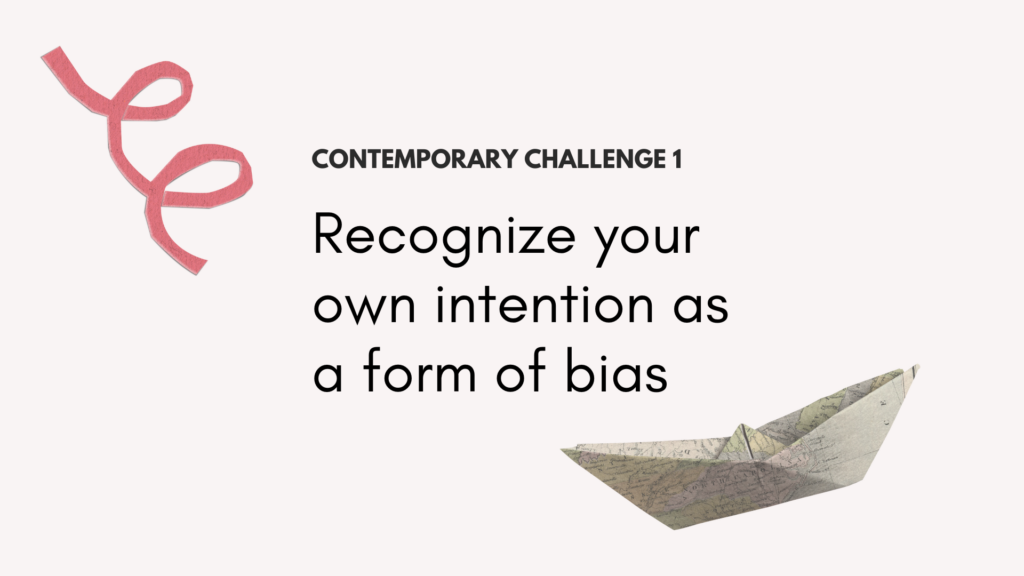
Recognizing our own intentions as a form of bias
Contemporary sensemakers are being looked to continually keep other people’s bias in check.
As self proclaimed user-centered folks, we tend to excel at this task of policing the world’s bias and advocating for decisions to be made from a more holistically informed perspective.
We have also finally come around to the idea that our stakeholders matter, and are in many ways users of our work too. We have worked as an industry to bring empathy to both users AND stakeholders.
On a bad day, this can feel like a pendulum swinging wildly between two objectives: Advocating for users and empathizing with stakeholders.
The question then becomes who is keeping your bias in check while we do all that swinging in the extremes?
The interesting paradox is that to be contemporary sensemakers we need to also develop an understanding that we sensemakers, just like anyone else, can’t escape approaching decisions with our own intentions as our bias.
Becoming aware of your own bias, and working with it as an expected material in your process is an area of improvement for most sensemakers, this sensemaker included.
At the heart of this finding, I am hoping to get word out that a sensemaker’s level of self-awareness directly impacts how the sensemaking work is done, through what lens success and failure is viewed, and what resources are given to this kind of work now and in the future.
By understanding our own place in the process, the bias that comes along with it, and introducing that bias as information in our process, I believe we can slow the pendulum and start to introduce a balance.
The black and white interpretation is that we are standing between two audiences trying to serve both. The rainbow of kind realism is that it takes many thoughtful compromises to serve multiple audiences appropriately based on the set intention for the sensemaking being done.
The ability to balance understanding our role, our intentions, and other people’s roles and intentions while managing the impact of bias is a critical skill of any contemporary sensemaker.

Creating a sense of safety and transparency in experimentation
Contemporary sensemakers are doing high-wire acts and in many cases it seems that the nets have been or are being removed. We are being asked to make sense of contexts, technologies and data sets that are newer than the degrees most of us hold – and in order to do that we need safety and transparency – as well as the ability for experiments to fail. Instead we have work environments where failure is absolutely not a part of success.
This impacts how innovative we can be in our sensemaking solutions and limits our ability to try new methods and tools. The paradox I want to highlight in this area is that we are potentially the ones suffering the most from this currently, yet also we are the ones that hold the keys to changing this part of how we work over time.
The role of experimentation is to integrate failure into our outcomes, not to always prove success in our plans.
The black and white interpretation of this is that we are continually waging a battle between those that care about risk too much and those that care about it too little. The rainbow of kind realism is that it’s a group of people who care the right amount about the right things and it is the culture around the work that needs to change.
By using some of our well honed research skills on the cultural parts of what is holding us back from creating more safety and transparency in experimentation we can model what it looks like to do evaluative research that actually evaluates. Then as we generate insights and opportunities to harness them, we can further model what it looks like to try something when we know it could fail.
The ability to create a sense of safety and transparency when experimenting in sensemaking work is one of the most uphill climbs contemporary sensemakers are currently climbing. But keep climbing sensemaker, the next generation needs us now more than ever before.
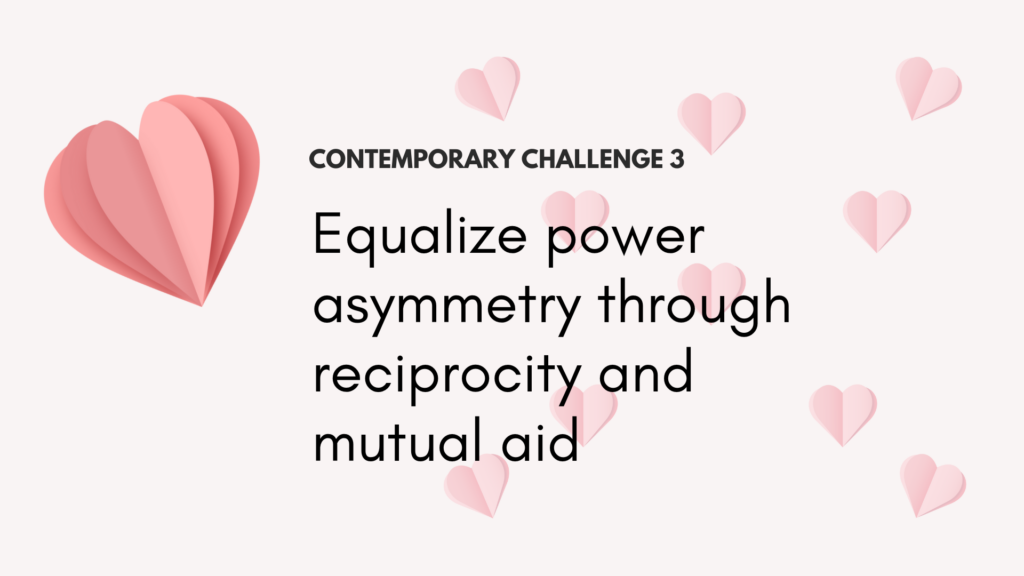
Equalizing power asymmetry through reciprocity and mutual aid
Contemporary sensemakers both acknowledge and work within the power asymmetry that exists, and impacts the world we are making sense in and of.
Power asymmetry impacts our ability to make sense as much as it impacts other people’s ability to interact with organizations whose leadership is shielded from the realities of their power struggles.
Sensemaking work is critical to point to power’s impact on what other people experience, and there are two intentions under which power asymmetry tends to get dampened:
- Reciprocity: Creating a balance of give-and-take
- Mutual Aid: Addressing common needs and challenges collectively
By focusing more of our sensemaking efforts on increasing reciprocity and mutual aid we can get more people into the conversation and have more viewpoints and voices represented in sensemaking work throughout an organization, not just from a single sensemaker.
The black and white interpretation of this is as a push and pull between power tyrants and power busters. The rainbow of kind realism is that it is more often about balancing what we know about power asymmetry with what we truly believe needs to change to meet the intentions of the organization. It isn’t usually about the extinguishing of power, it’s more about directing the flames to do the most good and the least harm.
The ability for sensemakers to acknowledge power asymmetry is only step 1, the next and harder part is integrating reciprocity and mutual aid into your sensemaking process like a vaccine against that asymmetry.
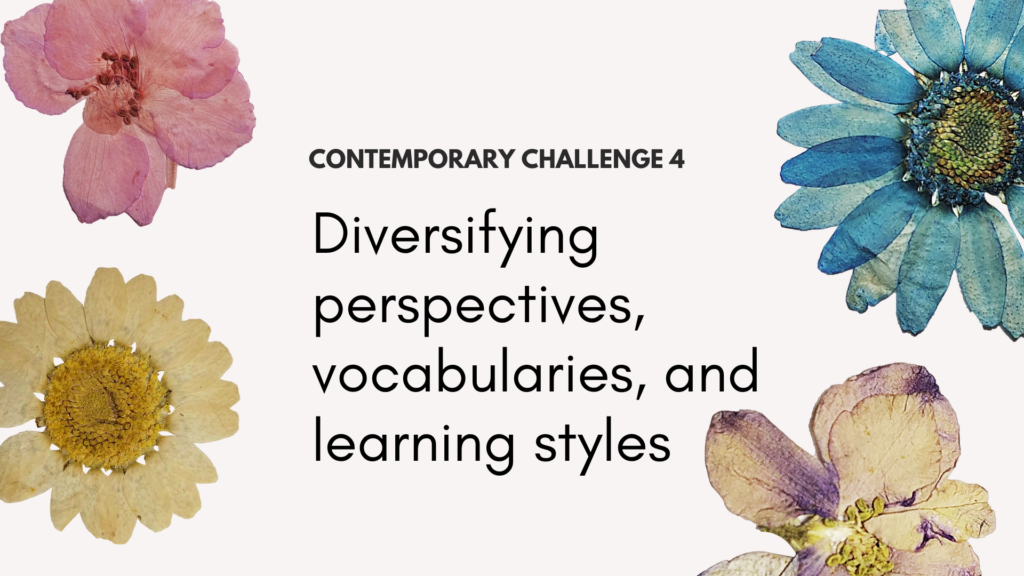
Diversifying perspectives, vocabularies, and learning styles
Contemporary sensemakers are making sense of new mediums, using new methods, new tools and serving new user behaviors and expectations. On top of that we are also still making sense of a complexifying set of learning styles, vocabularies and perspectives.
As the complexity increases we might feel like we know less than ever before. That feeling can serve sensemakers today in a clearer way than in quieter times of the past. When we feel as if we don’t know enough we are more likely to diversify the perspectives, vocabularies and learning styles we engage with in our sensemaking.
The black and white of this is designing just for yourself, and designing for everyone. The rainbow of kind realism is that both are problems to be balanced in most sensemaking contexts.
We cannot just design for ourselves, and yet we can’t serve every user with a single sensemaking solution. Instead sensemakers are more successful when they can understand the context, intention and audience and diversify perspectives, vocabularies and learning styles accordingly. The good news is that this is nothing new to us sensemakers, having made sense of every innovation that has come before up to now. We must trust that while the mediums are changing, our curiosity about people remains the key.
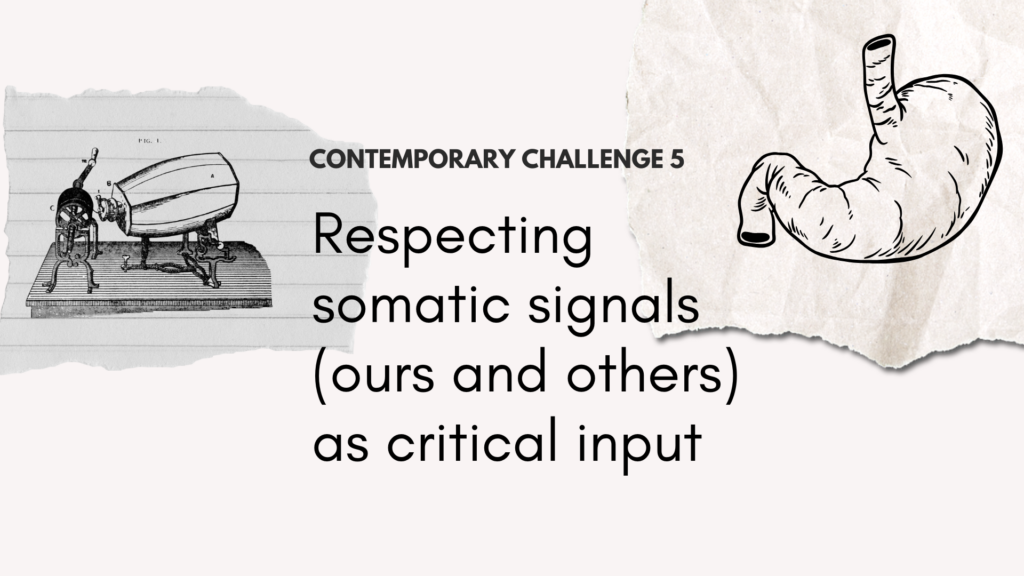
Respecting somatic signals (ours and others) as critical input
Contemporary sensemakers are waking up to the fact that feelings matter, and that somatic inputs matter. Sometimes as much as the data we have worked so hard to collect and cultivate usefulness from outside of ourselves.
Somatic means “relating to the body, especially as distinct from the mind” in short it confirms what we inherently know about our guts often holds keys our minds do not.
This new reality of self-actualization and healthy working relationships impacts sensemakers because we have to bring in a whole new level of insight into our work, especially our work with other people. In short: if our gut feelings matter, other people’s gut feelings matter as well.
The black and white of this can feel like it is between those worshiping data at the altar of profit and those woo woo folks following their guts. The rainbow of kind realism is that contemporary sensemaking requires us to integrate both our gut and the data into our final decision. We can’t rely on data to tell us the right next thing to do, just like we can’t rely on our gut to tell us how many widgets we sold last month. We have to balance the data and the somatic realities of the situation to get it right.

Zooming in while maintaining the ability to zoom out
Contemporary sensemakers are often being asked to focus on the pieces instead of on the whole. They are asked to dissect things to a level where they can be tweaked, tested or improved upon. Unfortunately this kind of work can become a death by a thousand cuts where every move is bringing the patient closer to death. That metaphor is gorey, but so are the corporate dissections in process most weekdays.
The black and white of this may feel like a battle between those who want to break it all down and those that want to blow it all up and start again. But the rainbow of kind realism is it turns out successful sensemaking is more often found in the balance of the two. Sensemakers need the ability to dissect but they also need the ability to zoom out and put a piece into context a few levels of abstraction above the level they are focused on.
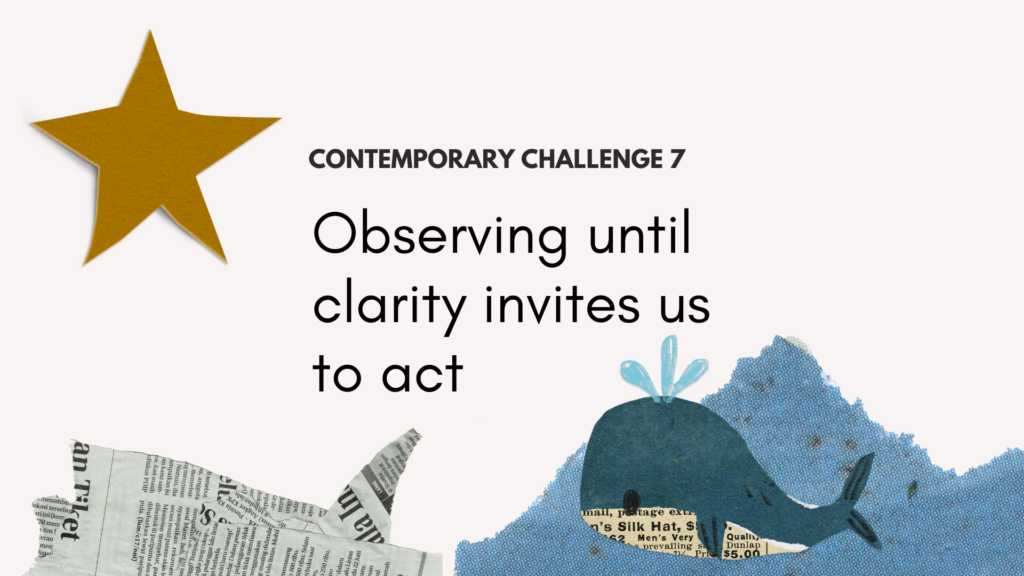
Observing until clarity invites us to act
Contemporary sensemakers are wondering collectively about the balance we should be striving for between observing and taking action. We are more aware of more sources of data and insight than ever before, and this level of access can make it more difficult to know when to stop observing and act on what you have observed.
Not knowing how much observation deserves an action impacts sensemakers by confusing the intention of our sensemaking as clarity instead of progress which is more often the intention we are given. We need clarity to get to action, but how much clarity is enough to act.
The black and white of this seems like a battle between analysis paralysis and throwing spaghetti at walls to see what sticks. The kind realism is it is that sensemakers need to be able to model that clarity is what invites us to act. When we are clear about something, and lack the ability to act on it without others, we need to do that tougher work of bringing others to clarity, so they too can get to action.
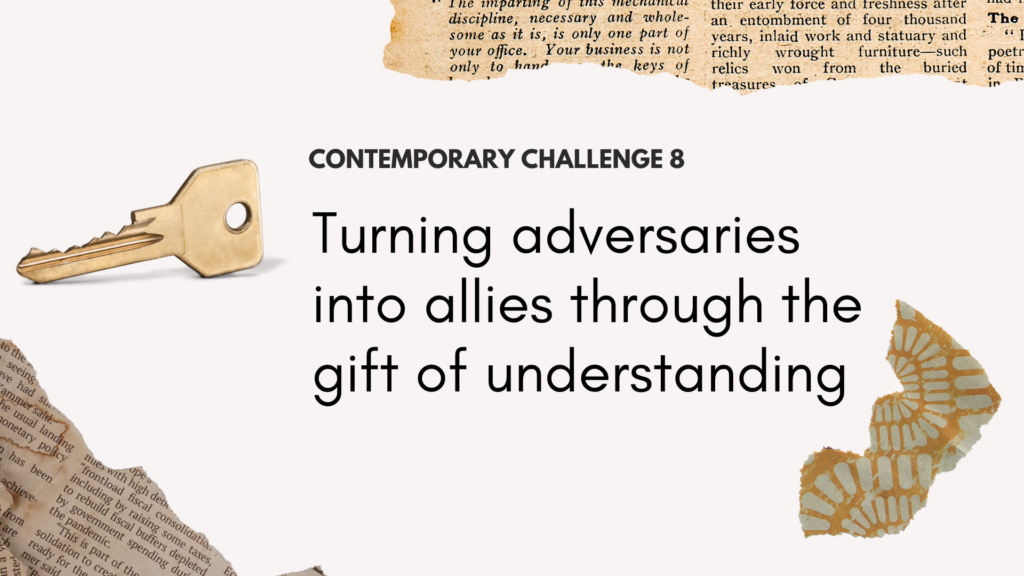
Turning adversaries into allies through the gift of understanding
Contemporary sensemakers are working in environments plagued with confusion about big things like culture, process and roles. The work is changing, the tools are changing, the words we use to describe them are changing, and sensemakers are often the bringers of change.
Being bringers of change means sensemakers are put in the unique position of changing people’s minds and hearts. When people feel scared (as change often inspires) we have a tendency to tense up, and reject that which we do not understand. This is for our own protection. When we are asking others to change, we do better when we anticipate the tension, and provide the right kind of clarity to relieve it.
The black and white of this seems like an unsorted pile of sensemaking adversaries and sensemaking allies waiting to be categorized. The rainbow of kind reality is it turns out it’s more often just a bunch of scared adults who lack clarity on what the required changes look like for them. And we sensemakers have the flashlights, and aren’t afraid to go looking in the dark corners to find and give the gift of understanding.
The excellent, and well planned news reveal of this talk is that “community” is the key to all eight of these areas in which we seek to improve to better withstand the anxiety and turbulence ahead:
- A community of peers, juniors and elders helps us recognize of our own bias
- A welcoming community provides a sense of safety in exploring our ideas
- A community of committed individuals can engage us in reciprocity and mutual aid
- A diverse community broadens our perspectives
- A community can give us the feeling of being seen, which is key to understanding ourselves somatically
- A community of practice models examples of what it means to Zoom In/Out on a variety of projects and contexts
- A self-sustaining community provides invitations to observe, and act even when our professional position is stuck in one or the other
- A community of strangers provides valuable practice in making allies (and friends)
When I started the Sensemakers Club six months ago, after hearing all these themes brewing at our Salon, I could not have predicted how this list would fit like a glove for the community we are creating here. I am so proud of how we are building this place one piece at a time, while maintaining focus on our goal:
Make sure no sensemakers go it alone.
In closing, I want to call the audible that contemporary sensemakers are facing challenges of scale and complexity the likes of which humankind has never made sense of before.
In order to do our best work, we sensemakers will need to:
- Recognize our own intentions as a form of bias
- Create a sense of safety and transparency in experimentations
- Equalize power asymmetry through reciprocity and mutual aid
- Diversify perspectives, vocabularies, and learning styles
- Respect somatic signals (ours and others) as critical input
- Zoom in while maintaining the ability to zoom out
- Observe until clarity invites us to act
- Turn adversaries into allies through the gift of understanding
If you want to be part of the community for whom this annual address was written, The Sensemakers Club hosts a new peer-led discussion every weekday on a variety of topics of interest to sensemakers of many mediums and seasons.
If you want to support my work as an independent creator, consider buying my work directly from me in my shop.
